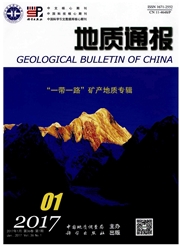

 中文摘要:
中文摘要:
研究沉积作用对层间氧化带砂岩型铀矿成矿作用的控制,对于进一步丰富砂岩型铀矿成矿理论,为砂岩型铀矿找矿和科研工作提供重要的技术指导具有重要作用。以伊犁盆地南缘为例,在分析伊犁盆地地质特征的基础上,以沉积作用与砂岩型铀矿主要控矿因素的关系为研究重点,系统解析了铀成矿过程中沉积作用对铀源、岩性岩相、地下水动力、层间氧化带和地球化学障的控制作用。研究表明:(1)风化、搬运作用将破碎的富铀火山岩屑带入含矿砂体中,为盆地后生铀矿床的形成提供了丰富的铀源;(2)沉积作用对岩性岩相有直接的控制作用,并进一步控制矿体的形态和空间展布特征;(3)砂体通道为地下水径流必须具备的前提条件,而砂体的展布方向也在很大程度上决定了含氧含铀地下水的渗流方向;(4)层间氧化带在平面上的展布形态与砂体的展布形态十分相近,垂向上多发育于粒度相对较粗、渗透性相对较好的底部砂体中;(5)地球化学障为铀成矿的地球化学环境,是沉积期原生环境和沉积期后成岩环境的综合。上述分析进一步表明:沉积物风化、搬运、堆积(环境)、成岩等沉积作用较大程度地影响和控制着伊犁盆地南缘层间氧化带砂岩型铀矿的形成和富集,分析结果对于该区进一步开展铀矿找矿勘探工作有一定的参考价值。
 英文摘要:
英文摘要:
Studying the controlling effect of sedimentation to the mineralization of inter-layer oxida- tion zone sandstone type uranium deposit is good to enrich the theory of sandstone type uranium deposits, and provide important technical guidance for the exploration and research work of sandstone type uranium deposits. Taking the southern margin of Yili basin as the study area, based on analyzing the geological characteristics of Yili basin, the relationship between sedimentation and the controlling factors of sand- stone type uranium deposit as the study focus, the controlling effect of sedimentation to uranium source, li- thology and lithofacies, groundwater dynamics, inter-layer oxidation zone and geochemical barrier in the process of uranium mineralization are analyzed. The study results show that : ①the broken volcanic detritus bearing rich uranium is brought into the ore-bearing sand body by weathering and transportation, which provided abundant uranium source for the formation of uranium deposits;②the lithology and lithofacies are controlled directly by sedimentation, and the shape and spatial distribution characteristics of the orebody are further controlled by sedimentation;③the sand body channel is the prerequisite for the groundw- ater flow, to a great extent, the direction of the seepage of oxygen and uranium bearing groundwater is de- termined by the distribution direction of sand body;④the distribution shape of inter-layer oxidation zone in the plane is very close to the one of sand body, in the vertically direction, the inter-layer oxidation zone is generally developed in the bottom sand body with relatively coarse grain size and good permeability ;⑤ geochemical barrier is the geochemical environment of uranium mineralization, which is the integration of the primary environment of sedimentary phase and post-depositional diagenetic environment. The above a- nalysis results further indicated that the formation and enrichment of the inter-layer oxidation zone sand- stone type uranium deposit in t
 同期刊论文项目
同期刊论文项目
 同项目期刊论文
同项目期刊论文
 期刊信息
期刊信息
